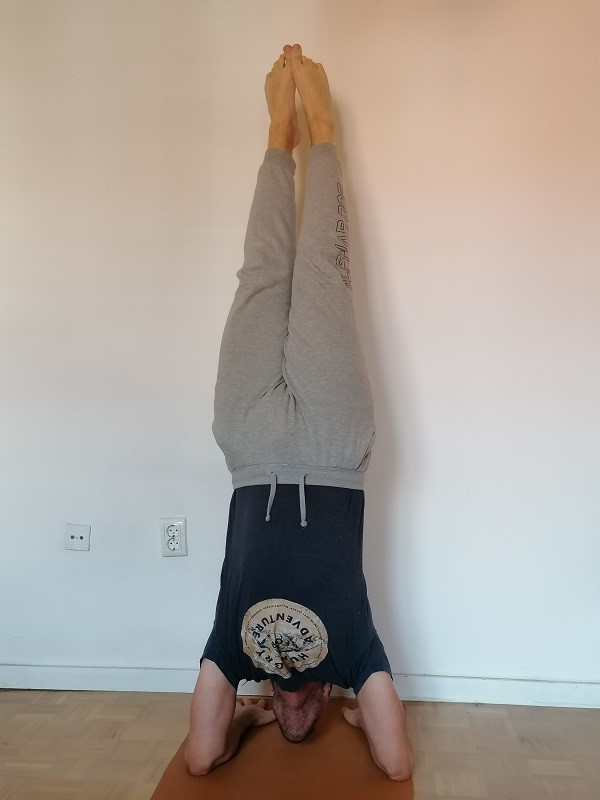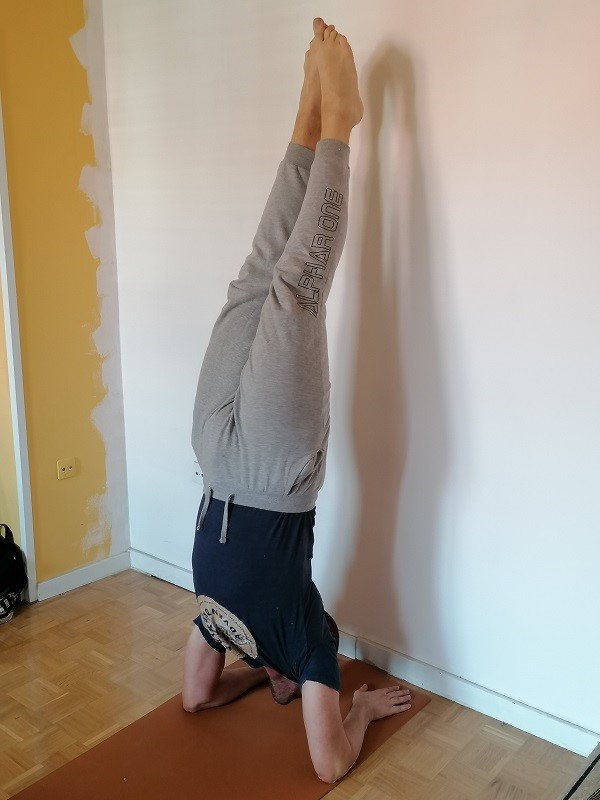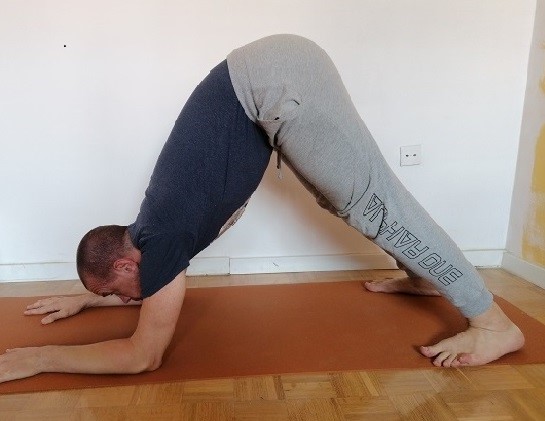Pincha Mayurasana is a very demanding pose in yoga.

Before we start dissecting the pose itself, why it is good, who can do it and who can’t, how to prepare for it, we will make a short introduction about the name itself in Sanskrit.
PINCHA MAYURASANA – HATHA YOGA
Many poses in yoga are named after the different animals.
Based on ancient writings, it can be found that there are over 8.4 million different yoga poses. However, in Hatha Yoga, which represents the basic style of yoga, there are considered to be 84 so-called classical yoga poses. All other poses are derived from these. Consequently, they only represent the variations of classical poses. According to Hatha Yoga scriptures, Pincha Mayurasana is one of those 84 classic postures.
Pincha Mayurasana in Sanskrit means feathered peacock.

The feathered peacock is a pose of balance, but it is also a pose of strength and endurance. It is certainly not a pose that should be practiced by people who are at the beginning stages of their yoga practice.
It should also be practiced in the presence of an experienced instructor or teacher, since the preparation for entering this pose is very important.
PREPARATORY POSES
In order to perform this pose in the right way, you need a lot of confidence in yourself, but also a lot of preparation. The pose itself implies that your whole body is involved in its performance. Almost every muscle in your body is activated when performing this pose.
A frequent obstacle when performing this pose is the practitioner’s fear of not being able to stay in the pose itself. That he will lose his balance, that he will fall and injure himself. Having this fact in mind, it can be said that to perform this pose, you not only need to be physically ready, but also your mental strength should come to the fore.
As we mentioned a little while ago, this pose, in addition to developing a sense of balance, also develops strength in the practitioner.
Consequently, in order to perform the feathered peacock correctly, we recommend that you first do the so-called preparatory poses for a period of time.
That is the practice of which will primarily develop strength in your upper body. The poses that allow you to more easily become aware of the support in the feathered peacock is the support on the forearms.
The first pose is well known to everyone – the forearm plank. While performing this pose, try to keep your forearms firmly resting on your yoga mat. Keep your forearms shoulder-width apart. You will use this same width when entering the feathered peacock pose.
With the help of this pose, you become aware of the support (forearms) for the feathered peacock pose and at the same time, you strengthen your core and quadriceps.
You can stay in a forearm plank for a minimum of 10 inhales and exhales.
When performing the forearm plank, use mula and uddiyana bandha. In that way, you will stay longer and you will also develop your core muscles.
Bandhas are also an integral part when performing a feathered peacock pose.
The second pose that also affects many levels when it comes to preparing to enter the feathered peacock pose is the boat (naukasana) pose. Try practicing the second or third variation of this pose.
The second variation involves your legs being fully extended upwards while you rest on your tailbone with your arms extended forward.
The third variation involves interlacing your hands and placing them on the back of your head. The legs and arms are in the pose of variation two. This variation is a bit more demanding as it engages your core more.
The boat pose strengthens your core, but this pose is great for strengthening your quadriceps, hip flexors, stretching your hamstrings and abdominal muscles. The hamstring stretch is most noticeable in variations 2 and 3 when the legs are fully extended upwards.
You can also stay in the boat pose for a minimum of 10 inhales and exhales. Of course, in case that number is a big challenge for you right now, feel free to follow the comfort of your body, without forcing it.
The third pose that we would advise you is the eagle position – Garudasana. This pose, if you do it fully, greatly affects the development of your sense of balance.
If you already have a developed sense of balance, you can practice only one part of this pose specifically the part about opening up the space between your shoulder blades. In that case, you can practice the pose itself while sitting. Since you do not include the balance pose, you are only to practice the upper part of the eagle where you open your shoulder blades.
If you are practicing the standing eagle pose which affects the development of the sense of balance, try to stay for a minimum of 10 inhales and exhales.
If you only practice a sitting pose, a pose that affects the opening of your shoulder blades, feel free to try to stay in the same pose for a few minutes. Stay for 3 minutes on each side if you can.
The fourth pose that we definitely recommend is the dolphin position – Ardha Pincha Mayurasana. The pose itself affects the strengthening of your upper musculature. This pose is, in my opinion, the most important of all the poses mentioned. You can practice this pose in several ways.

You can enter the basic dolphin pose and stay in it for a minimum of 10 inhales and exhales. You can also practice the variations of this pose.
The first variation involves lifting of one leg as far back as possible. In this way, in addition to strengthening the upper body, you work on opening your hips.
The second variation involves doing push-ups from the dolphin pose. From the basic pose, gently slide your shoulders forward. Do not go too far forward. Roll your shoulders back. If you can, repeat this movement at least 10 times. There is also a variation where you do push-ups with one leg raised. In case your upper body is not developed to a great extent, we would not advise you to try this variation.
BENEFITS
Practicing the Feathered Peacock pose affects, as we pointed out a moment ago, the development of your upper body. Practicing this pose opens the space between your shoulder blades, strengthens your shoulders, forearms, and wrists. You develop a better sense of balance.
Feathered Peacock pose strengthens your core muscles and works to fine-tune the length of your spine. It develops a feeling of lightness in the thighs, considering that it is an inverted position. Therefore, whether you like it or not, you simply have to develop that feeling of lightness in your thighs.
You also develop control over your bandhas. Until you master and learn how to use bandhas in the right way, you will hardly be able to perform this pose fully. On the other hand, the pose itself is excellent to improve circulation, digestion, calms the mind (given that it is an inverted position, it is quite logical) and reduces stress.
CONCLUSION
Pincha Mayurasana is a very demanding pose. Our recommendation is that you don’t get into this pose if you don’t have a developed sense of balance, developed strength in your upper musculature, and developed control over your bandhas. Be sure not to skip the preparatory poses. They exist precisely to gradually prepare you for the full pose. Remember that everything is a process and everything takes time.







